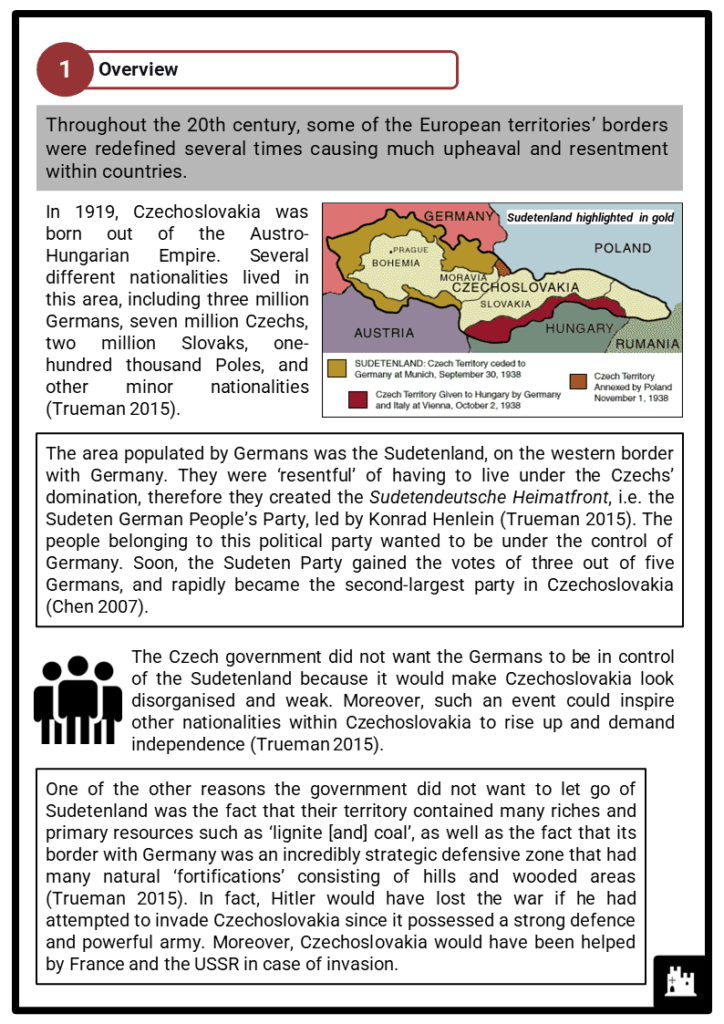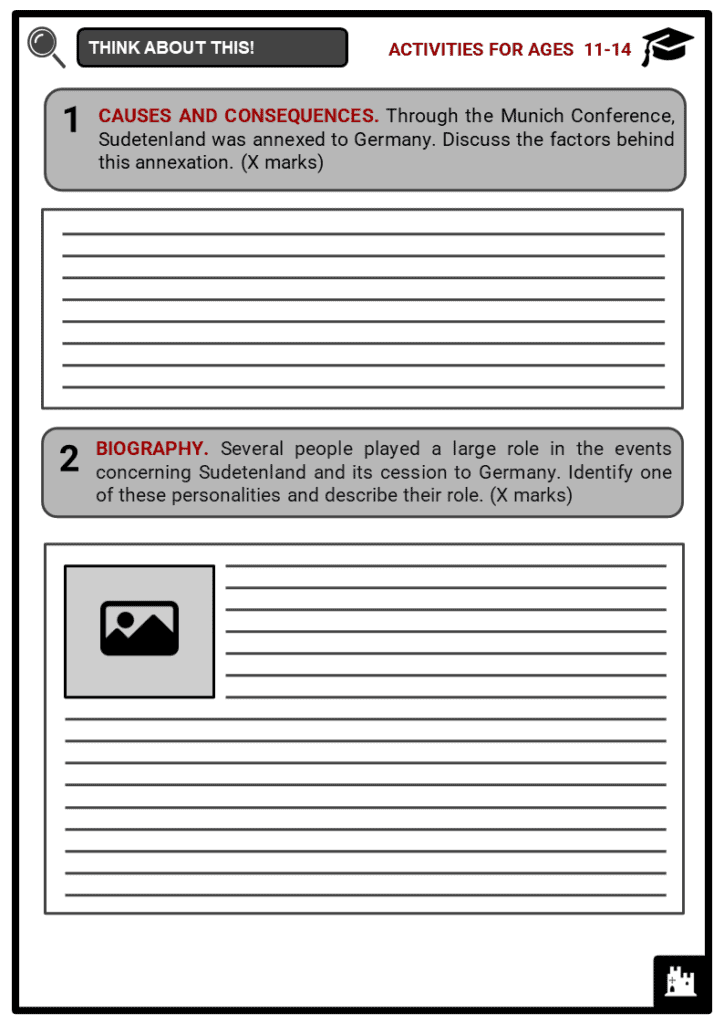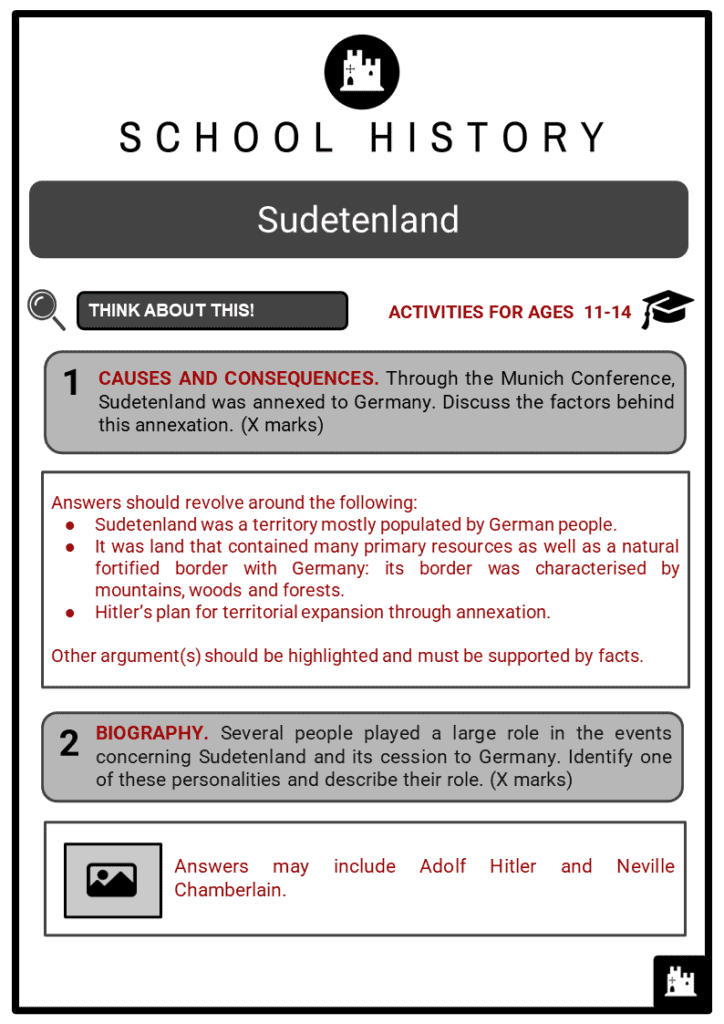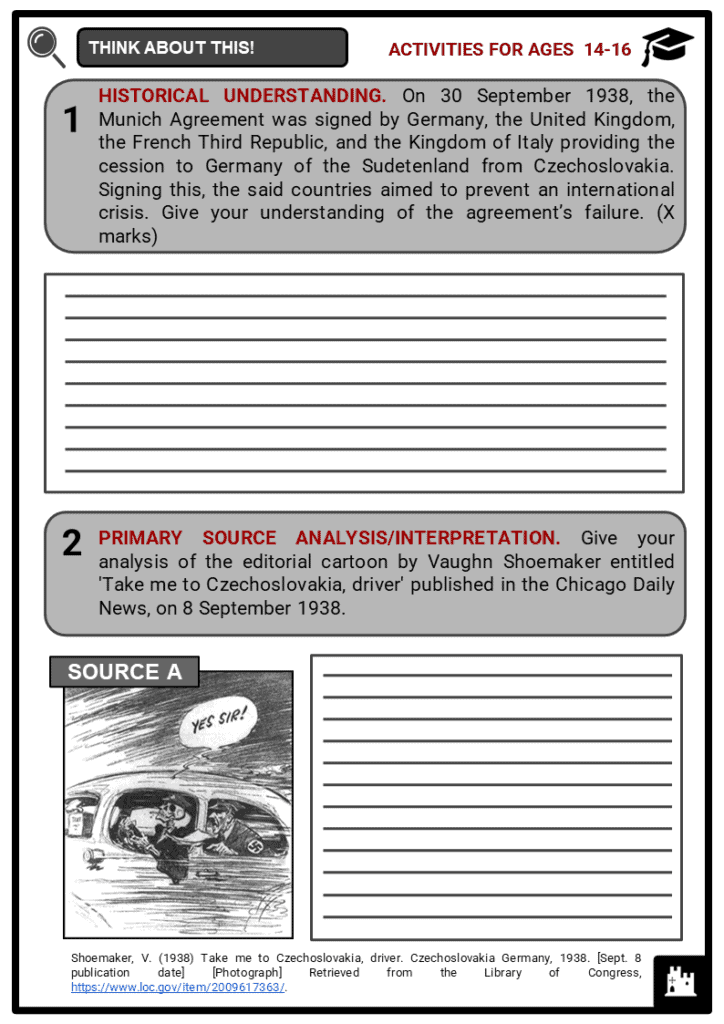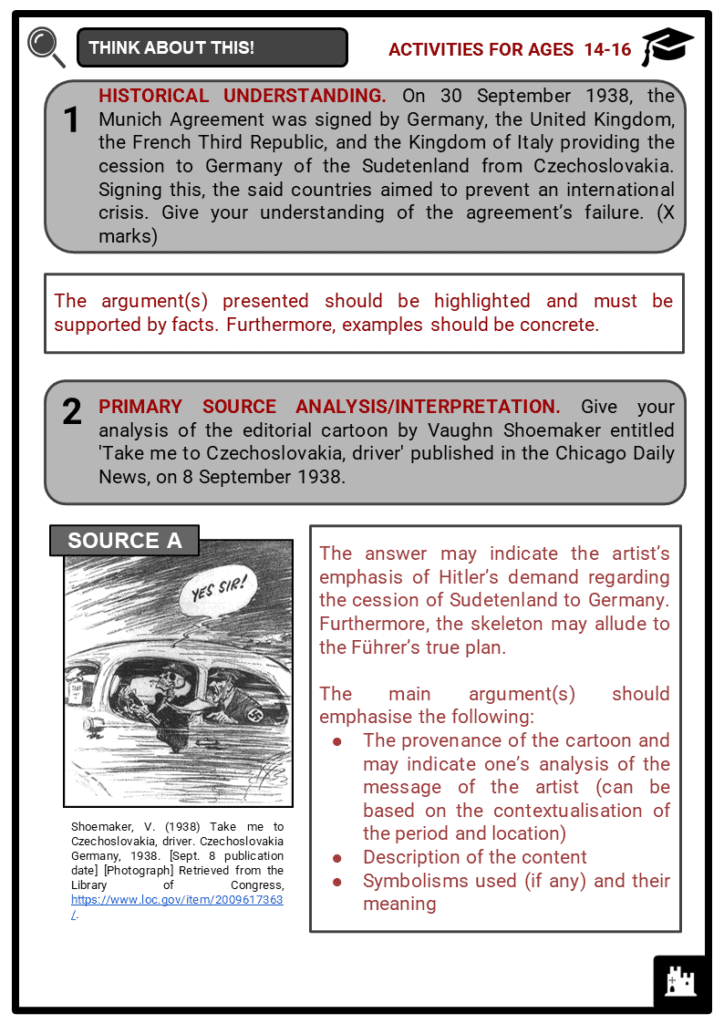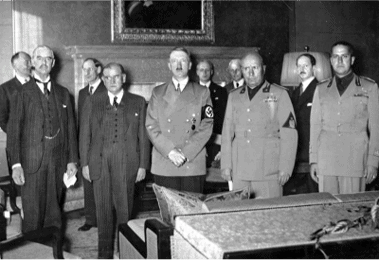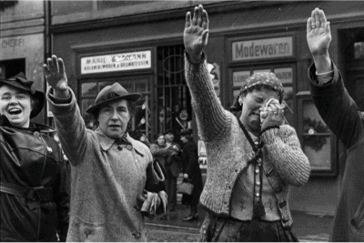Download Sudetenland Worksheets
Do you want to save dozens of hours in time? Get your evenings and weekends back? Be able to teach Sudetenland to your students?
Our worksheet bundle includes a fact file and printable worksheets and student activities. Perfect for both the classroom and homeschooling!
Table of Contents
Add a header to begin generating the table of contents
Summary
- The factors behind the cession of Sudetenland to Germany.
- The key features of the Munich Conference.
- The impact of the Munich Conference.
Key Facts And Information
Let’s find out more about Sudetenland!
- Sudetenland was a territory mostly populated by German people. This land was part of Czechoslovakia, i.e. a new country that was born out of the Austro-Hungarian Empire. It was land that contained many primary resources as well as a natural fortified border with Germany: its border was characterised by mountains, woods and forests.
- Hitler wanted to annex Sudetenland to Germany. He therefore financed the Sudeten German People’s Party in order to create chaos and upheaval within the country. He met Chamberlain twice in order to discuss the annexation.
- In 1938, following Mussolini’s suggestion, he attended the Munich Conference with Mussolini himself, Chamberlain and Daladier. Hitler obtained the annexation of Sudetenland.
- Britain and France believed that by conceding the Czech territory to the Germans, another world war would be avoided.
Overview
- Throughout the 20th century, some of the European territories’ borders were redefined several times causing much upheaval and resentment within countries.
- In 1919, Czechoslovakia was born out of the Austro-Hungarian Empire. Several different nationalities lived in this area, including three million Germans, seven million Czechs, two million Slovaks, one-hundred thousand Poles, and other minor nationalities (Trueman 2015).
- The area populated by Germans was the Sudetenland, on the western border with Germany. They were ‘resentful’ of having to live under the Czechs’ domination, therefore they created the Sudetendeutsche Heimatfront, i.e. the Sudeten German People’s Party, led by Konrad Henlein (Trueman 2015). The people belonging to this political party wanted to be under the control of Germany. Soon, the Sudeten Party gained the votes of three out of five Germans, and rapidly became the second-largest party in Czechoslovakia (Chen 2007).
- The Czech government did not want the Germans to be in control of the Sudetenland because it would make Czechoslovakia look disorganised and weak. Moreover, such an event could inspire other nationalities within Czechoslovakia to rise up and demand independence (Trueman 2015).
- One of the other reasons the government did not want to let go of Sudetenland was the fact that their territory contained many riches and primary resources such as ‘lignite [and] coal’, as well as the fact that its border with Germany was an incredibly strategic defensive zone that had many natural ‘fortifications’ consisting of hills and wooded areas (Trueman 2015). In fact, Hitler would have lost the war if he had attempted to invade Czechoslovakia since it possessed a strong defence and powerful army. Moreover, Czechoslovakia would have been helped by France and the USSR in case of invasion.
- Considering the situation, Hitler did not surrender in his ambition to annex the Czech territory; in fact, he supported the Sudeten German Party ‘both verbally and financially’. He also encouraged the party to ‘create trouble’ in Sudetenland in order to prove to Czechoslovakia and the rest of the world that the country was not able to maintain peace and order (Trueman 2015).
- In 1938, the Nazi Party divulged false myths about the German people living in Czechoslovakia: their propaganda recounted ‘stories [of] oppressed Germans’ (Chen 2007).
- Although Hitler did not have to bargain much with Neville Chamberlain and Daladier in order to obtain control over Sudetenland, the future Führer was not entirely happy: he would have preferred if the English and French leaders had demonstrated more resistance. In fact, if they had turned down Hitler’s proposals, he would have had a reason to take over the whole of Czechoslovakia by force (Chen 2007).
1938 - Hitler’s annexation of Sudetenland
- After having extended his power to the Rhineland and Austria between 1936 and 1938, Hitler soon identified his new ambition: obtaining control over Sudetenland, i.e. a territory in Czechoslovakia.
- Adolf Hitler received British Prime Minister Neville Chamberlain twice. The first time was at his home in Berchtesgaden, in the Bavarian Alps. Although the future Führer’s requests to Chamberlain were absurd, he soon realised he was obliged to comply. In fact, he wanted the United Kingdom to accept and encourage the German annexation of Sudetenland, as well as permit the Germans of Czechoslovakia to join the Third Reich (Cavendish 2008).
- The second meeting between Chamberlain and Hitler happened on 22 September 1938, in Bad Godesberg, near Bonn. Hitler’s requests had slightly changed following their first meeting, and he required permission for the German troops to occupy Sudetenland, as well as the re-annexation of the territories containing more than 50% Poles and Magyars respectively to Poland and Hungary (Trueman 2015). Chamberlain considered Hitler’s demands impractical and highly unlikely. Therefore, both the British and French government rejected Hitler’s proposals.
- Faced with a negative response from the two European powers, Hitler met with the Italian fascist leader, Benito Mussolini, in order to develop a plan of action. At this point, Mussolini suggested Hitler organise a conference with the four other powers in order to attempt a resolution. The meeting was held in Munich. During the conference, there were no representatives of the Czech government: only the Czech ambassador was invited to Munich as an adviser. However, he was not allowed to enter the same room as Hitler.
- When the Munich Conference was held on 28-29 September 1938, with the presence of the British, French, German and Italian leaders, Hitler was granted Sudetenland. The German leader was resolute in fulfilling his expansionist ambitions, and sources claim that as soon as the British Prime Minister left Munich, Hitler claimed: ‘If ever that silly old man comes interfering here again with his umbrella, I’ll kick him downstairs’ (Cavendish 2008).
- Moreover, Hitler defined the peaceful agreement that he signed with Chamberlain as a ‘scrap of paper’ (Trueman 2015).
- Chamberlain agreed to Hitler’s annexation of Sudetenland, for two reasons. The first reason was that Chamberlain was not aware of Hitler’s plans to dominate Europe. In fact, his primary objective was that of avoiding a new world war after the events of 1914-1918. In essence, the British Prime Minister believed that by making such a concession to Germany, their ambitions of territorial expansion would be sedated (Cavendish 2008).
- The second reason was that Britain would have been immediately crushed if it entered war against Germany: in fact, its air force was still weak since it was ‘undergoing [some] changes’, and its navy would not have been any use in the Czechoslovakian territory. In essence, Chamberlain was strongly encouraged not to entertain any conflicts with Hitler since, in case of bombing, Britain would have not been able to cope with the deaths of over one million people: ‘mass graves would be needed as there simply would not be enough wood for timber coffins’ (Trueman 2015).
- When Chamberlain returned to Britain, he was enthusiastically welcomed and recognised as the man who had dodged another world war. Therefore, Chamberlain was received at Buckingham Palace: standing on the palace’s balcony next to George VI and Queen Elizabeth, he was greeted wholeheartedly by his audience; and on Downing Street, he made ‘one of history’s most celebrated misjudgments’ since he claimed “I believe it is peace for our time” (Cavendish 2008).
- Similarly, the French Daladier was also eager to avoid another bloody and costly war at all costs. He also claimed: “[w]e won’t tolerate war over this, the Czechs will just have to give way. We will simply have to force them to the cession” (Chen 2007).
- On 1 October, the Germans marched into Sudetenland. On this occasion, the Czech premier, General Jan Sirovy, addressed the Czechs on the radio: “I am fulfilling the most painful duty which can ever have fallen upon me, a duty which is worse than dying … the forces arrayed against us oblige us to recognise their superiority and act accordingly” (Cavendish 2008; citing Sirovy).
- The people that were not German and that lived in Sudetenland were forced to leave their homes and land within ten days (Chen 2007).
- The loss of Sudetenland to the Germans was of great significance to Czechoslovakia. In fact, the newborn country was deprived of its two main strengths: on the one hand, it lost its great natural defence and the ‘man-made fortifications’ which were just as strong as the French Maginot Line; on the other hand, Czechoslovakia could no longer had the economic benefits deriving from Sudetenland (Chen 2007).
- Not being able to reap the financial rewards deriving from ‘industrial facilities, mines, roads, and railways’ signified that the Czechs lost ‘66% of its coal production, 80% of lignite, 86% of chemicals, 80% of cement, 80% of textiles, 70% of electric power, 40% of timber, and 70% of iron and steel’ (Chen 2007).
After the War
- In May 1945, Czechoslovakia was liberated and the term Sudety or Sudetenland was officially banned. Instead, pohraniční území or border territory would be used.
- As part of the Potsdam Conference, Sudeten Germans were expelled from Czechoslovakia. This was also because anti-German sentiments prevailed due to the implication of Nazism. However, Germans who were able to prove their anti-Nazi association remained.
- It was estimated that around 500,000 Germans were expelled. It was noted that 3,149,820 (est.) Germans lived in Czechoslovakia in 1930 and by 1950, only 159,938 (est.) remained.
Image sources:
- https://upload.wikimedia.org/wikipedia/commons/9/9d/Bundesarchiv_Bild_183-H12751%2C_Godesberg%2C_Vorbereitung_Münchener_Abkommen.jpg
- https://upload.wikimedia.org/wikipedia/commons/9/9c/Bundesarchiv_Bild_183-R69173%2C_Münchener_Abkommen%2C_Staatschefs.jpg
- https://upload.wikimedia.org/wikipedia/commons/c/c2/Bundesarchiv_Bild_183-H13160%2C_Beim_Einmarsch_deutscher_Truppen_in_Eger.jpg


